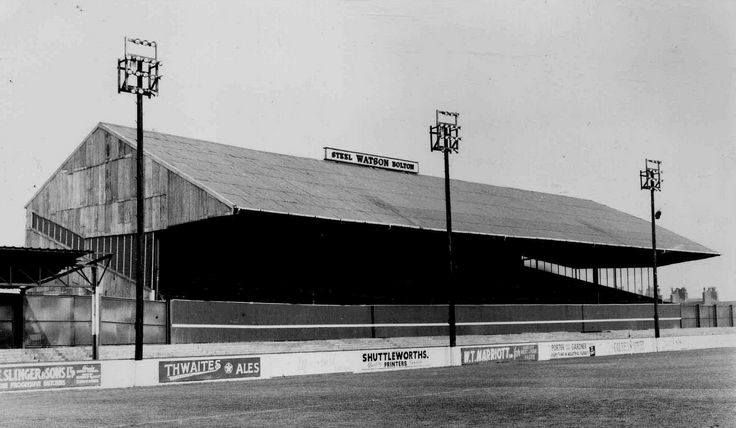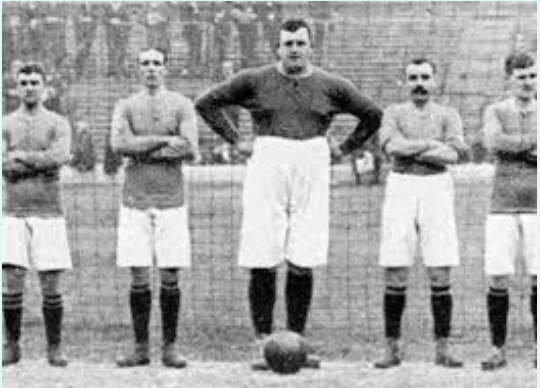 |
 |
 |
“Accrington Stanley”….Possibly the most famous Lower League – Formerly non league, club name in World Football. Now riding high in League One, Stanley’s fame however possibly stems from their less than glorious past… That and a Milk advert !! The club now play at the smart, modern Crown Ground or Wham Stadium as it is currently known. But before they disbanded in 1966, the club played at the long since lost Peel Park. The site is now occupied by Peel Park Primary school and the pitch is the school playing field, and used by a Sunday League team, but the old stadium once rocked to the noise of 17,634 fans for a friendly match with Blackburn Rovers in November 1954

Ariel view of Peel Park with the illfated Burnley Rd stand in the foreground and the huge sprawling open terrace on the left
Accrington FC had been founder members of the Football League, however they are often confused with Accrington Stanley who where a completely different football club that gained entry to the Football league in 1921
and remained there until the club went bust and resigned from the League in 1962.. The current Stanley reformed in 1968. The name Accrington Stanley having come from an amalgamation of Accrington FC and and local amateur team Stanley Villa who were based at The Stanley Arms on Stanley Street as long ago as 1900. The original Accrington FC resigned from the league in 1893 Accy “Stanley” joined The Lancashire Combination in 1900 and won the Championship in 1903.

The impressive looking Burnley Road stand, the cost of which was instrumental in the club going out of business in 1962
The Burnley Road stand had been built in 1958 with Stanley at the top of The 3rd Division and looking to get promotion to the 2nd tier of English football, The stand could accomodate 4,700 fans (including standing at the front and sides) and was bought from Aldershot FC at a “bargain” £1,450. However, the price of dismantling, transportation and rebuilding the stand added another £10,000 to the overall cost. Stanley had to reduce playing costs to pay for the stand and as a result, the manager at the time Walter Galbraith resigned, and with him went Stanley’s chance of promotion.
The club found itself in financial difficulty and just 4 years after the ambitious expansion of the stadium, the club resigned from the football League on 12th March 1962, unable to even complete the seasons fixtures.

A Painting of Peel Park, in it’s pomp
Courtesy: http://www.stadiumportraits.com
Prior to the building of the Burnley Road stand, Stanley and Peel Park had enjoyed some success, from 1954 to 1958 they consistently challenged for promotion and Peel Park saw it’s highest attendances. A crowd of 15,425 watched Stanley play York City in April 1955 in a top of the table clash. Average home attendances during this period were around 7,000

Match action from a packed Peel Park
By 1962 with the club now in financial dire straits and relegated to Division 4, gates where down to around 2,000. The PFA led by Jimmy Hill had in 1960 managed to abolish the maximum wage for players and Stanley simply couldn’t compete with the wages being asked by players. The inevitable followed.

Sparsely populated stand and terraces signalled the end for Stanley

The dilapidated ground before demolition.
Photo courtesy: British Grounds
An interesting piece of football folklore is said to have occurred in a 1907 Accrington Stanley FA Cup tie at Bradford City. The legendary keeper Willie “Fatty” Foulke was in goal for Bradford and his jersey clashed with the red of Accrington. A suitable different coloured jersey that would fit him, couldn’t be found, so a sheet was wrapped around the giant frame of Fatty Foulke. Bradford won the game and it’s said the giant keeper never had to dive during the match…. Leading to the now weekly used statement of “he kept a clean sheet” !!! Is it True? Well, who knows. You decide :)

Willie “Fatty” Foulke
Next time I’m going to look at another long lost ground. Park Avenue in Bradford. Link to the Bradford page is on the home page